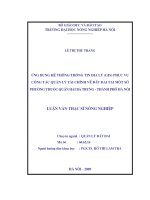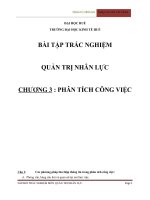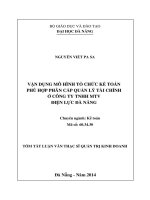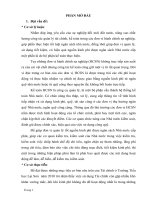Chap018 SORT TERM FINANCE AND PLANNING TRẮC NGHIỆM QUẢN TRỊ TÀI CHÍNH BẰNG TIẾNG ANH
Bạn đang xem bản rút gọn của tài liệu. Xem và tải ngay bản đầy đủ của tài liệu tại đây (108.48 KB, 23 trang )
Chapter 18
Short-Term Finance and Planning
Multiple Choice Questions
1.
The length of time between the purchase of inventory and the receipt of cash from
the sale of that inventory is called the:
A. operating
cycle.
B. inventory
period.
C. accounts receivable
period.
D. accounts payable
period.
E. cash
cycle.
Refer to section 18.2
2.
The length of time that elapses between the day a firm purchases an inventory
item and the day that item sells is called the:
A. operating
cycle.
B. inventory
period.
C. accounts receivable
period.
D. accounts payable
period.
E. cash
cycle.
Refer to section 18.2
3.
Central Supply purchased a toboggan for inventory this morning and paid cash for
it. The time period between today and the day Central Supply will receive cash
from the sale of this toboggan is called the:
A. operating
cycle.
B. inventory
period.
C. accounts receivable
period.
D. accounts payable
period.
E. cash
cycle.
Refer to section 18.2
4.
Costs that increase as a firm acquires additional current assets are called _____
costs.
A. carryin
g
B. shortag
e
C. orde
r
D. safet
y
E. tradin
g
Refer to section 18.3
5.
Steve has estimated the cash inflows and outflows for his hardware store for next
year. The report that he has prepared recapping these cash flows is called a:
A. pro forma income
statement.
B. sales
projection.
C. cash
budget.
D. receivables
analysis.
E. credit
analysis.
Refer to section 18.4
6.
Taylor Supply has made an agreement with its bank that it can borrow up to
$10,000 at any time over the next year. This arrangement is called a(n):
A. floor
loan.
B. open
loan.
C. compensating
balance.
D. line of
credit.
E. bank
note.
Refer to section 18.5
7.
If you pay your suppliers five days sooner, then:
A. your payables turnover rate will
decrease.
B. you may require additional funds from other sources to fund the
cash cycle.
C. the cash cycle will
decrease.
D. your operating cycle will
increase.
E. the accounts receivable period will
decrease.
Refer to section 18.2
8.
Which one of the following will increase the accounts payable period, all else
constant?
A. an increase in the cost of goods sold account
value
B. an increase in the ending accounts payable
balance
C. an increase in the cash
cycle
D. a decrease in the operating
cycle
E. an increase in the accounts payable
turnover rate
Refer to section 18.2
9.
Which one of the following managers determines which customers must pay cash
and which can charge their purchases?
A. purchasing
manager
B. credit
manager
C. controll
er
D. production
manager
E. payables
manager
10.
On average, Furniture & More is able to sell its inventory in 27 days. The firm takes
87 days on average to pay for its purchases. On the other hand, its average
customer pays with a credit card which allows the firm to collect its receivables in
4 days. Given this information, what is the length of operating cycle?
Operating cycle = 27 + 4 = 31 days
11.
Davis and Davis have expected sales of $490, $465, $450, and $570 for the
months of January through April, respectively. The accounts receivable period is 28
days. What is the accounts receivable balance at the end of March? Assume a year
has 360 days.
March ending receivables = (28/30) $450 = $420
12.
The Athletic Sports Store has a beginning receivables balance on January 1 of
$410. Sales for January through April are $440, $480, $690, and $720,
respectively. The accounts receivable period is 60 days. How much did the firm
collect in the month of April? Assume a year has 360 days.
April collections = February sales = $480
13.
On May 1, your firm had a beginning cash balance of $175. Your sales for April
were $430 and your May sales were $480. During May, you had cash expenses of
$110 and payments on your accounts payable of $290. Your accounts receivable
period is 30 days. What is your firm's beginning cash balance on June 1?
Cash balance = $175 - $110 - $290 + $430 = $205









